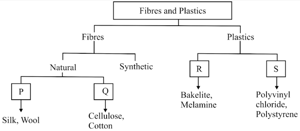Anil Ahlawat Solutions for Chapter: Synthetic Fibres and Plastics, Exercise 1: EXERCISES
Anil Ahlawat Science Solutions for Exercise - Anil Ahlawat Solutions for Chapter: Synthetic Fibres and Plastics, Exercise 1: EXERCISES
Attempt the practice questions on Chapter 3: Synthetic Fibres and Plastics, Exercise 1: EXERCISES with hints and solutions to strengthen your understanding. NSO Science Olympiad Workbook Grade 8 solutions are prepared by Experienced Embibe Experts.
Questions from Anil Ahlawat Solutions for Chapter: Synthetic Fibres and Plastics, Exercise 1: EXERCISES with Hints & Solutions
Fill in the blanks by picking up the correct words.
Fibres are materials that are usually thin and have a thread-like structure. They are generally classified as and , on the basis of their origin. Natural fibres may be plant fibres like or animal fibres like .
Sneha has classified a few materials as shown in the table.
| S. No. | Material | Type/Nature |
| 1. | Nylon | Synthetic and non-biodegradable |
| 2. | Jute | Natural and non-biodegradable |
| 3. | Coir | Synthetic and biodegradable |
| 4. | Wool | Natural and biodegradable |
| 5. | Acrylic | Blended and biodegradable |
| 6. | Polyester | Synthetic and non-biodegradable |
The materials which are classified incorrectly are
Anisha prepared a flow chart to show the classification of fibres and plastics. She left a few columns blank. Fill in the blanks by selecting the option with the correct words.

A few polymers are grouped together on the basis of some common properties as follows:
Group I : Rayon, acrylic, nylon, jute
Group II : PVC, melamine, teflon
Group III : Polycot, terrywool, acrylic
Select the odd one out in groups I, II and III.
Which of the following applications of plastics show(s) that plastics are bad conductors of electricity?
I. Refrigerators have insulating wool of plastics
II. Electric wires have a plastic coating
III. Chemicals are stored in plastic containers
IV. Parachutes are made from plastics
Read the given passage and fill in the blanks by selecting an appropriate option.
Cellulose is a naturally occurring fibre. The walls of __(i)__ are made of cellulose. It is used in making a synthetic fibre __(ii)__ which resembles the most expensive natural fibre __(iii)__ in appearance hence, it is also called __(iv)__.
Read the following statements carefully.
P. I am extensively used in the healthcare industry, but my one disadvantage is that I am non-biodegradable
Q. I am very familiar form of polyester and used for making bottles, utensils, films, wires, etc
R. I am artificial silk and mixed with wool to make carpets
and are
Match column I with column II and select the correct option from the given codes.
| Column I | Column II | ||
| P. | Nylon | (i) | Burns quickly with a smell of burning paper |
| Q. | Wool | (ii) | Burns with sooty flame, fabric shrinks and black beads are formed |
| R. | Acrylic | (iii) | Shrinks after exposure to flame, forms hard beads and gives a smell of burning hair |
| S. | Rayon | (iv) | Burns slowly with a smell of burning hair |
